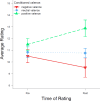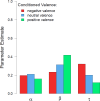The role of evaluatively conditioned stimuli in iconic memory
- PMID: 39322864
- PMCID: PMC11522187
- DOI: 10.1007/s00426-024-02024-w
The role of evaluatively conditioned stimuli in iconic memory
Abstract
In the present study, an attempt was made to replicate results found about the influence of valence on prioritisation and decay in iconic memory. Hereby, the evaluative conditioning effect was used to induce valence for formerly neutral stimuli. The effect is gained by pairing neutral stimuli with either positive, negative, or neutral images in a conditioning phase. Afterwards, the conditioned stimuli acted as targets in an iconic memory test. In the iconic memory test, targets were presented together with seven other stimuli on a circular placement on the screen for a short time. A cue delayed by either 17, 68, 221, 493, or 1003 ms pointed at the target to be reported. Participants rated the targets before and after the conditioning phase. In addition, the affective and neutral images used in the pairing procedure were rated at the end of the experiment. While no significant change in rating could be observed for the conditioned targets, a significant effect of conditioned valence was still present in the response times and the accuracy of the iconic memory test. Participants reacted the quickest in response to a cue for positively conditioned targets compared to neutral or negatively conditioned targets. Accuracy was highest for positively conditioned targets and was lowest for negatively conditioned targets. Unlike in prior studies, slower decay of information in iconic memory for negative targets was not revealed. Further research should be conducted to identify reasons for this inconsistency.
Keywords: Evaluative conditioning; Iconic memory; Valence; Visual processing.
© 2024. The Author(s).
Conflict of interest statement
None.
Figures






Similar articles
-
Enhanced early visual processing after evaluative conditioning.Acta Psychol (Amst). 2019 Jun;197:1-9. doi: 10.1016/j.actpsy.2019.04.009. Epub 2019 Apr 28. Acta Psychol (Amst). 2019. PMID: 31030084
-
Revisiting the prioritization of emotional information in iconic memory.R Soc Open Sci. 2020 Oct 7;7(10):191507. doi: 10.1098/rsos.191507. eCollection 2020 Oct. R Soc Open Sci. 2020. PMID: 33204435 Free PMC article.
-
Read-out of emotional information from iconic memory: the longevity of threatening stimuli.Psychol Sci. 2011 May;22(5):695-700. doi: 10.1177/0956797611406445. Epub 2011 Apr 22. Psychol Sci. 2011. PMID: 21515741
-
Evaluative learning with single versus multiple unconditioned stimuli: the role of contingency awareness.J Exp Psychol Anim Behav Process. 2009 Apr;35(2):286-91. doi: 10.1037/a0013255. J Exp Psychol Anim Behav Process. 2009. PMID: 19364238
-
Acquisition of Conditioned Responses to a Novel Alcohol-Paired Cue in Social Drinkers.J Stud Alcohol Drugs. 2016 Mar;77(2):317-26. doi: 10.15288/jsad.2016.77.317. J Stud Alcohol Drugs. 2016. PMID: 26997190 Free PMC article.
References
-
- Alves, H., & Imhoff, R. (2023). Evaluative context and conditioning effects among same and different objects. Journal of Personality and Social Psychology: Attitudes and Social Cognition, 124(4), 735–753. 10.1037/pspa0000323 - PubMed
-
- Baeyens, F., Vansteenwegen, D., Hermans, D., & Eelen, P. (2001). Human evaluative flavor-taste conditioning: Conditions of learning and underlying processes. Psychologia Belgica, 41, 169–186. 10.5334/pb.979
-
- Benjamini, Y., & Hochberg, Y. (1995). Controlling the false discovery rate: A practical and powerful approach to multiple testing. Journal of the Royal Statistical Society Series B (Methodological), 57(1), 289–300. 10.2307/2346101
-
- Brainard, D. H. (1997). The Psychophysics Toolbox. Spatial Vision, 10, 443–446. 10.1163/156856897x00357 - PubMed
MeSH terms
LinkOut - more resources
Full Text Sources

